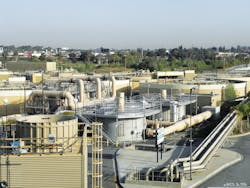About the author: Caitlin Cunningham is managing editor of Water & Wastes Digest. Cunningham can be reached at [email protected] or 847.391.1025.
When it comes to wastewater treatment plants, the Joint Water Pollution Control Plant (JWPCP) of the Los Angeles County Sanitation Districts (LACSD) is one of the world’s largest. In operation since 1928, the facility currently serves more than 3.5 million people in Los Angeles County, providing primary and secondary wastewater treatment for approximately 300 million gal per day (mgd) and capable of handling up to 400 mgd.
The plant site comprises 418 acres in Carson, Calif., about half of which act as buffer zones—recreational, commercial and habitat—between operations and residential neighbors. It plays a central role in the LACSD’s Joint Outfall System (JOS), a network of seven treatment plants and 1,300-plus miles of trunk sewers that treats wastewater for 73 cities and unincorporated county territory. The JWPCP is the network’s largest facility and processes removed solids for all JOS plants. Ninety-nine operations personnel, 160 maintenance workers, 35 electrical and instrumentation specialists, and 24 administrators staff it.
Impressive not only in its sheer size, the JWPCP has earned prestigious industry recognition. Most recently, it took top Large Secondary Plant honors in the U.S. Environmental Protection Agency’s 2009 Clean Water Act Recognition Awards, selected primarily for outstanding operations and maintenance practices. Also in 2009, the National Association of Clean Water Agencies bestowed upon it a Platinum 8 title, commending the facility’s eighth consecutive year of total compliance with its National Pollutant Discharge Elimination System permit limits.
“The JWPCP combines wastewater treatment with innovative resource recovery, intensive environmental monitoring programs and sensitivity to the surrounding community to create a state-of-the-art facility,” said Supervising Engineer David Frediani.
Primary Treatment
The wastewater treatment process begins with three influent sewers sending flow to two inlet works, the first of which handles about 70% of the plant’s total flow, with the second taking on the remainder. Bar screens capture large debris, and rakes pull it into a trough. Screenings are delivered to one of two dewatering compactors, then disposed of in a landfill; the water removed is sent back upstream of the bar screens. After going through the bar screens, wastewater effluent is directed via inlet sewage pumps to one of six grit chambers.
In order to prevent infrastructure abrasion and to conserve digester volume, heavy inorganic material is removed in grit chambers, with influent flow controls and aeration helping achieve the desired solids deposition. At this point, the wastewater travels through velocity-regulating inlet gates to sedimentation tanks for additional solids removal. The JWPCP houses 52 primary sedimentation tanks that have been grouped into three batteries. Settled solids are pushed to a sludge hopper at the influent end of the tank, and floatable solids are pushed to the effluent end. The settled solids are pumped to raw sludge transfer stations, and the floatable solids are processed through a skimmings trough, one of four skimmings wet wells and a skimmings concentration tank.
Next, sludge undergoes anaerobic digestion in tanks. The JWPCP’s two sludge transfer stations deliver raw sludge to circular anaerobic digesters—24 in all, each heated to 96°F and with a volume of roughly 500,000 cu ft. Once digested, the sludge pours into runoff piping, travels to its pump stations and heads to the solids processing area for dewatering.
Secondary Treatment
Secondary treatment begins with the secondary influent pumping station, which pumps primary effluent upward to the secondary treatment facilities through a 14-ft-diameter pipe. The effluent first receives treatment in eight biological reactors, each of which is covered and designed to handle about 50 mgd. The mixed liquor then flows over a weir, through clarifier inlet channels and into clarifiers, where activated sludge solids are separated out.
A dissolved-air floatation system and cryogenic oxygen plant further support the secondary treatment process, from which the secondary effluent ultimately is disinfected with bleach and pumped or gravity fed to Pacific Ocean outfalls.
Solids Processing
Digested sludge is sent to the plant’s centrifuges—27 low-speed and eight high-speed units—for polymer-aided dewatering. Dried cakes are transported via conveyor belts, stored temporarily in silos if needed and hauled off site. Centrate is sent to a special treatment system.
The plant has reused biosolids ever since its doors opened more than eight decades ago. It has adopted practices including soil amendment distribution, agricultural application and landfill disposal that produces gas to fuel the facility’s power plant.
Notable Achievements
The JWPCP produces its own power. Three digester gas-fired turbines and one steam turbine meet all electricity and steam requirements, and any surplus electricity is sold to the utility.
In 2007, the plant dedicated a new compressed natural gas facility that provides alternative fuel for area customers as well as 120 JWPCP vehicles.
Since 2000, the LACSD as a whole has invested more than $71 million in odor and air emission reduction efforts. A 24-hour telephone hotline and quarterly meetings between the JWPCP Citizens Advisory Committee and LACSD provide residents with outlets for voicing odor and dust concerns.
Editor’s Note: The LACSD JWPCP will host a facility tour the afternoon of Oct. 17 in conjunction with WEFTEC.11. Additional registration is required.
Download: Here
